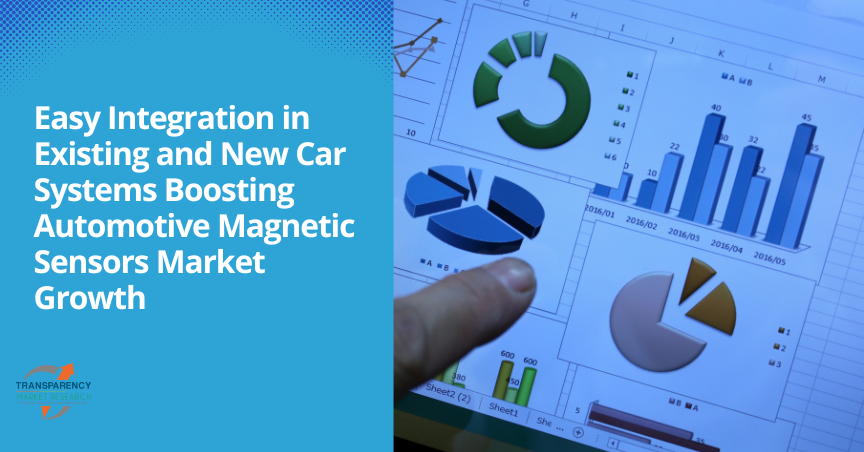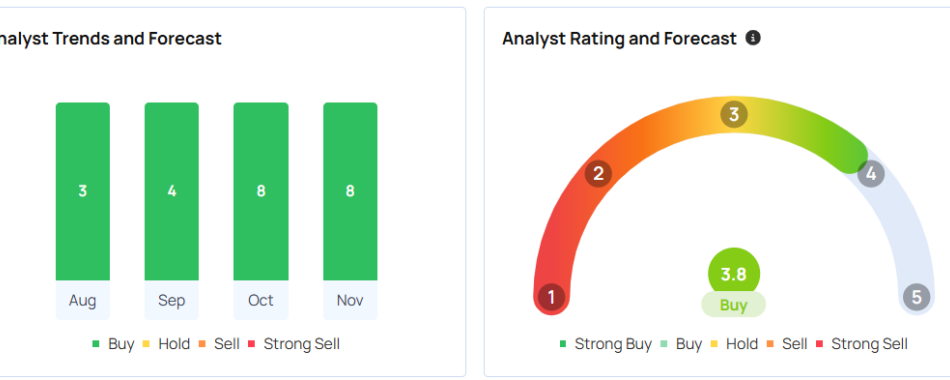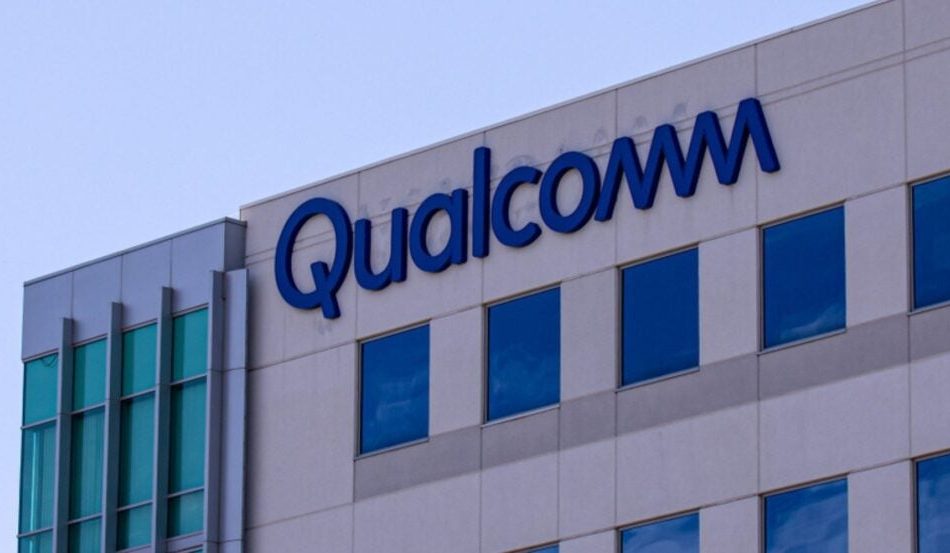Rumble Stock Rises In Tuesday Pre-Market After Adopting Bitcoin Treasury Strategy As BTC Retreats
Rumble Inc. RUM saw a 5.75% rise in pre-market trading on Tuesday, as per Benzinga Pro, following the announcement of a new Bitcoin BTC/USD treasury strategy.
What Happened: According to an announcement made Monday, Rumble’s board has approved a plan to invest a portion of its surplus cash reserves into Bitcoin, aligning with the cryptocurrency’s record-breaking performance.
Meanwhile, Bitcoin dropped to 92,325.34 during pre-market hours after failing to break the $100,000 level.
The strategy involves potential investments of up to $20 million, with the company having discretion over the timing and amount. This could translate to acquiring approximately 212 Bitcoins at current market prices. However, the management will determine the actual purchase based on market conditions and Bitcoin’s price.
This move is part of Rumble’s broader strategic initiative to explore the cryptocurrency market. The decision reflects a growing trend among companies to diversify their treasury holdings with digital assets, especially during periods of significant price movements in the crypto market.
See Also: Satellite Images Reveal North Korea Reportedly Receiving Illicit Oil from Russia
Why It Matters: Rumble’s decision to invest in Bitcoin is part of a broader strategy to expand its presence in the digital landscape. Recently, Rumble announced a partnership with popular streamer Dr. Disrespect, who will provide exclusive content to Rumble Premium and lead Rumble Gaming as an advisor. This move underscores Rumble’s commitment to gaming and cryptocurrency expansion.
Meanwhile, MicroStrategy Inc. MSTR, MARA Holdings Inc MARA and some other companies that hold Bitcoin have experienced a downward pull after Bitcoin’s slump.
Read Next:
Image via Shutterstock
Market News and Data brought to you by Benzinga APIs
© 2024 Benzinga.com. Benzinga does not provide investment advice. All rights reserved.
Automotive Magnetic Sensors Market to Generate US$1.8 Billion in Revenue by 2034, Fueled by ADAS Adoption | Latest Report by TMR
Wilmington, Delaware, United States, Transparency Market Research, Inc., Nov. 26, 2024 (GLOBE NEWSWIRE) — The automotive magnetic sensors market (自動車用磁気センサー市場) is experiencing significant expansion, fueled by the growing need for sophisticated driver assistance technologies and cutting-edge sensor solutions. By 2034, the market is expected to be valued at US$ 1.8 billion, as automakers seek to enhance vehicle safety, performance, and user experience.
Magnetic sensors are integral to various automotive systems, including ADAS, electric vehicle (EV) powertrains, and overall vehicle diagnostics. The development of more efficient and reliable sensors, such as Hall Effect and Giant Magneto Resistance (GMR) sensors, is transforming vehicle technologies, making them safer, smarter, and more energy-efficient.
Request a Sample PDF of the Report: https://www.transparencymarketresearch.com/sample/sample.php?flag=S&rep_id=86398
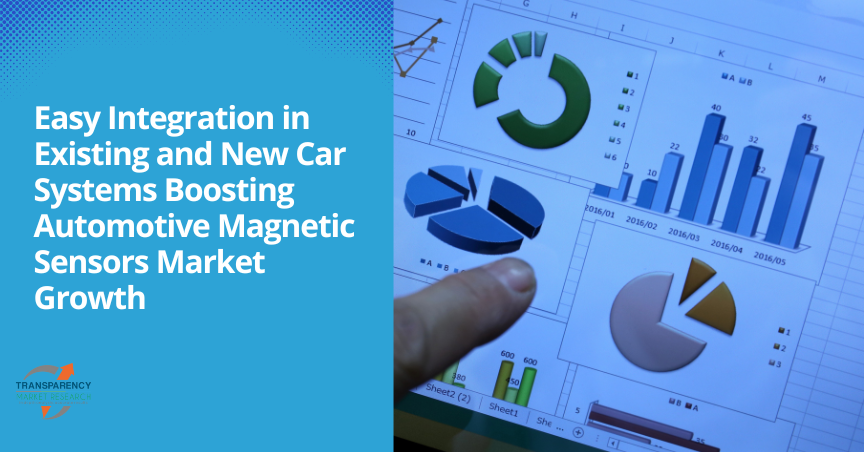
Key Drivers of Growth: ADAS Adoption and Technological Advancements
The integration of ADAS (Advanced Driver Assistance Systems) in vehicles is one of the leading factors propelling the demand for automotive magnetic sensors. These systems, which include technologies like lane departure warnings, adaptive cruise control, and automatic emergency braking, rely heavily on accurate and real-time data from sensors. Magnetic sensors help monitor key vehicle functions such as steering angles, wheel speeds, and suspension systems, playing a crucial role in ensuring the proper functioning of ADAS.
Technological advancements are also fueling market growth. Magnetic sensors with enhanced features, such as 3D magnetic sensors, are enabling more precise measurements and improving overall vehicle performance. Additionally, the rising adoption of electric vehicles (EVs) and hybrid electric vehicles (HEVs), which require precise control and monitoring of motors, batteries, and powertrains, is further boosting the demand for these sensors.
Notable Industry Developments and Innovations
- Hall Effect Sensors: Hall Effect sensors, which detect the presence of magnetic fields, are being increasingly used in ADAS applications and electric vehicle propulsion systems. They provide accurate position sensing and speed measurement, critical for the efficient functioning of these systems.
- Giant Magneto Resistance (GMR) Sensors: GMR sensors are gaining traction in automotive applications due to their ability to measure small changes in magnetic fields, offering enhanced precision and durability for various automotive systems.
- ADAS Integration: With automakers globally investing in ADAS technologies to enhance vehicle safety, the need for high-performance magnetic sensors has never been greater. The rising demand for vehicles with autonomous capabilities is further driving growth in this market.
- Electric and Hybrid Vehicles: Magnetic sensors are pivotal in EVs and HEVs for monitoring battery charge levels, controlling motors, and optimizing energy consumption.
Request Customized Data for in-depth market insights: https://www.transparencymarketresearch.com/sample/sample.php?flag=S&rep_id=86398
Automotive Magnetic Sensors Market Segmentation
The automotive magnetic sensors market is segmented based on type, technology, control interface, vehicle type, propulsion type, and sales channel:
- By Type:
- Magnetic Position Sensors
- Linear Sensors
- Angle Sensors
- 3D Magnetic Sensors
- Magnetic Speed Sensors
- Magnetic Switch
- By Technology:
- Hall Effect
- Anisotropic Magneto Resistance (AMR)
- Giant Magneto Resistance (GMR)
- Tunnel Magneto Resistance (TMR)
- Fluxgate
- SQUID
- Others
- By Control Interface:
- Analog
- I2C
- SPI
- PWM
- SENT
- SPC
- Others
- By Vehicle Type:
- Passenger Cars (Hatchbacks, Sedans, SUVs)
- Light Commercial Vehicles
- Heavy Duty Trucks
- Buses and Coaches
- By Propulsion Type:
- ICE Vehicles (Gasoline, Diesel)
- Electric Vehicles (Battery Electric Vehicles, Hybrid/Plug-in Electric Vehicles)
- By Sales Channel:
- Regions Covered:
- North America
- Central and South America
- Europe
- Asia Pacific
- Middle East & Africa
Trends Shaping the Automotive Magnetic Sensors Market
- Enhanced Sensor Technology: With advancements in magnetoresistive sensors, the market is seeing improvements in sensor precision, durability, and miniaturization. New technologies like TMR (Tunnel Magneto Resistance) sensors are opening up new opportunities for high-performance applications in ADAS and EVs.
- Autonomous and Electric Vehicle Demand: The increasing penetration of autonomous driving and electric vehicles is creating a demand for magnetic sensors to improve vehicle control and monitoring systems. These sensors are vital for systems like traction control, steering, and power management in EVs.
- Safety Features in ADAS: The integration of ADAS in mainstream vehicles has become a significant market driver. Sensors that provide real-time data on wheel speed, steering angle, and position are vital for the smooth functioning of these systems, which are now considered standard in many new vehicles.
Looking for a detailed regional analysis? Get our premium research report today!: https://www.transparencymarketresearch.com/checkout.php?rep_id=86398<ype=S
Strategic Outlook: Future Market Developments
As the automotive industry moves toward smarter, safer, and more energy-efficient vehicles, the demand for high-performance magnetic sensors will continue to rise. With innovations in sensor technology and increased adoption of ADAS and electric vehicles, the market is poised for significant expansion. By 2034, the automotive magnetic sensors industry is expected to reach US$ 1.8 billion, driven by technological advancements and the growing focus on vehicle safety and performance.
Trending Reports in Automotive Industry
- Automotive Exhaustive System Market (自動車排気システム市場): automotive exhaustive system market size is expected to reach a value of US$ 46.6 Bn by the end of 2034.
- EV Platform Market (EVプラットフォーム市場): EV Platform Market size is expected to reach a value of US$ 91.5 Bn by the end of 2034.
About Transparency Market Research
Transparency Market Research, a global market research company registered at Wilmington, Delaware, United States, provides custom research and consulting services. Our exclusive blend of quantitative forecasting and trends analysis provides forward-looking insights for thousands of decision makers. Our experienced team of Analysts, Researchers, and Consultants use proprietary data sources and various tools & techniques to gather and analyses information.
Our data repository is continuously updated and revised by a team of research experts, so that it always reflects the latest trends and information. With a broad research and analysis capability, Transparency Market Research employs rigorous primary and secondary research techniques in developing distinctive data sets and research material for business reports.
Contact:
Transparency Market Research Inc.
CORPORATE HEADQUARTER DOWNTOWN,
1000 N. West Street,
Suite 1200, Wilmington, Delaware 19801 USA
Tel: +1-518-618-1030
USA – Canada Toll Free: 866-552-3453
Website: https://www.transparencymarketresearch.com
Email: sales@transparencymarketresearch.com
Follow Us: LinkedIn| Twitter| Blog | YouTube

© 2024 Benzinga.com. Benzinga does not provide investment advice. All rights reserved.
Ask an Advisor: I'm 60 With $2.4 Million in Retirement Savings. How Do I Manage Withdrawals to Keep Healthcare Subsidies?
SmartAsset and Yahoo Finance LLC may earn commission or revenue through links in the content below.
At the age of 60, I recently entered retirement after being a business owner. I’ve been securing health insurance through the marketplace since its inception. Currently, my income is derived solely from withdrawing money from my taxable portfolio, comprising reported dividends and capital gains totaling less than $60,000 annually. An advantageous outcome of this approach is that the government covers roughly half of my health insurance costs.
In terms of assets, I possess $625,000 in my taxable portfolio, $115,000 in a Roth IRA and $1,500,000 in a traditional IRA. I am a homeowner, and I lack additional dependents. The plan moving forward involves drawing exclusively from the taxable portfolio until I reach the age of 65 to maintain the current strategy. I am uncertain whether this is a prudent approach or if I should consider tapping into other assets without being overly concerned about the health insurance benefit.
– Kevin
In this case, it makes sense to stick with the plan and draw down regular taxable assets. Drawing from a traditional IRA to have the same amount of disposable funds would create more taxable income and a larger tax bill.
When you add health insurance subsidies into the mix you get another benefit by not increasing your taxable income, which would happen simply by switching to a different source for your withdrawals. Plus, the longer you leave money in a retirement account, the more chance it has to grow without a tax drag. (And if you have additional tax or retirement questions, consider connecting with a financial advisor.)
The Premium Tax Credit (PTC) helps millions of Americans shoulder the burden of paying for their own health insurance. You can choose to pay lower premiums every month (called the advance premium tax credit) or get a credit for the full amount when you file your taxes.Unfortunately, enhancements made to the PTC as part of the American Rescue Plan and extended via the Inflation Reduction Act are set to expire after 2025. But until then, qualifying for the PTC gives you a larger discount on health insurance premiums.Only people who buy coverage through the health insurance marketplace are eligible to receive these credits. PTC amounts previously depended on income and household size, and were only available to families that earn between 100% and 400% of the federal poverty level.However, those limits won’t go back into effect until after 2025, assuming Congress doesn’t extend the PTC enhancements again. Until then, PTC eligibility for households that earn more than 400% of the federal poverty level hinges on what percentage of their income would be used to purchase the benchmark plan (second-lowest-cost Silver plan). So, if your household will spend more than 8.5% of your income on premiums, you may qualify for the PTC. (And if you want additional help finding tax breaks, consider working with a financial advisor.)
Polycystic Ovary Syndrome Treatment Market to Reach $6.84 Billion by 2034 with 4.7% CAGR | Fact.MR Report
Rockville, MD, Nov. 26, 2024 (GLOBE NEWSWIRE) — Polycystic ovarian syndrome is a disorder in which several tiny cysts (fluid-filled sacs) grow in the ovaries. The market is projected to expand steadily as more females around the world become aware of the risks associated with the condition. The global polycystic ovary syndrome (PCOS) treatment market is estimated to reach a valuation of US$ 4.33 billion in 2024 and further expand at a CAGR of 4.7% from 2024 to 2034.
One of the most common signs of PCOS is an irregular menstrual cycle. Women often opt for testing for PCOS upon noticing this symptom. Women are increasingly mindful of their health and actively endeavor to improve it and monitor for health concerns. All of these factors are boosting the adoption of PCOS treatment.
Treatment providers in the market are striving to gain a deeper understanding of women’s reproductive functions to enhance their treatment features, attracting more women to choose their treatment options. This is contributing to the expansion of the polycystic ovary syndrome treatment market size.
For More Insights into the Market, Request a Sample of this Report: https://www.factmr.com/connectus/sample?flag=S&rep_id=10043
 Key Takeaways from Market Study
Key Takeaways from Market Study
- The global polycystic ovary syndrome treatment market is expected to reach US$ 6.84 billion by 2034-end.
- The North American market is forecasted to expand at a CAGR of 4.3% till 2034.
- Oral contraceptives are estimated to account for 30.4% share of the market by 2024.
- Through 2034, the East Asia market is projected to expand at 6% CAGR.
- The Japanese market is projected to expand at a CAGR of 5.5% from 2024 to 2034.
- The PCOS market in Mexico is forecasted to reach a valuation of US$ 136 million by 2034-end.
“Rise in the prevalence of polycystic ovary syndrome worldwide prompts the development of effective treatment options. Increasing awareness and proactive measures are crucial for managing PCOS to improve women’s health worldwide,” says a Fact.MR analyst.
Leading Players Driving Innovation in the Polycystic Ovary Syndrome (PCOS) Treatment Market:
Key industry participants like Sanofi, Novartis AG, Teva Pharmaceutical Industries Limited, Addex Therapeutics Ltd., Bristol Myers Squibb Co., Ferring Pharmaceuticals, Crinetics Pharmaceuticals, AstraZeneca Plc, Aphena Pharma Solutions Tennessee, Inc., Lupin Pharmaceuticals, Sun Pharmaceutical Industries Ltd. etc. are driving the polycystic ovary syndrome (PCOS) treatment industry.
United States and China Profitable Markets for PCOS Treatment Providers:
Expansion of healthcare infrastructure in the United States, coupled with increased disposable income, has contributed to the adoption of insulin-sensitizing agents. Awareness campaigns by United States government entities have contributed to market growth in the nation. The market shows promising signs as proactive measures by the government become more prominent.
Prevalence of PCOS among women in China has increased significantly over the past decade. A significant number of reproductive-aged women in China are affected by PCOS. Therefore, national regulations and recommendations should be updated based on recent research. Consequently, the Chinese market holds lucrative opportunities for PCOS treatment providers.
Polycystic Ovary Syndrome (PCOS) Treatment Industry News:
- In June 2022, Bayer took a significant step by inaugurating its new Research and Innovation Center at Kendall Square in the United States. This move reinforces Bayer’s presence in one of the world’s most dynamic hubs for pharmaceutical research and development.
Get Customization on this Report for Specific Research Solutions:
https://www.factmr.com/connectus/sample?flag=S&rep_id=10043
More Valuable Insights on Offer
Fact.MR, in its new offering, presents an unbiased analysis of the polycystic ovary syndrome treatment market for 2018 to 2023 and forecast statistics for 2024 to 2034.
The study divulges essential insights into the market based on drug class (oral contraceptives, insulin-sensitizing agents, antidepressants, ornithine decarboxylase inhibitors, aromatase inhibitors & SERMs, diuretics) and distribution channel (hospital pharmacies, drug stores/OTC, e-Commerce, clinics), across six major regions of the world (North America, Latin America, Europe, East Asia, South Asia & Oceania, and MEA).
Check out More Related Studies Published by Fact.MR Research:
Contraceptives market size is set to increase from a value of US$ 33 billion to US$ 62 billion by the end of 2033.
Pregnancy point of care testing market is valued at US$ 1.5 billion in 2023 and is forecasted to secure US$ 2.33 billion in revenue by 2033-end.
Women’s health rehabilitation products market is predicted to increase from its current valuation of US$ 3.22 billion and reach US$ 5.77 billion by the end of 2033.
Insulin delivery devices market size have reached at US$ 16.8 Billion in 2023, and is expected to secure a valuation of US$ 33.1 Billion by 2033-end, with a growing compound annual growth rate (CAGR) of 7% during the forecast period from 2023 to 2033.
Insulin patch pumps market size was valued at US$ 840 Million in 2022 and is expected to accumulate a market value of US$ 932.40 Million by registering a CAGR of 11% in the forecast period 2022-2032.
About Us:
Fact.MR is a distinguished market research company renowned for its comprehensive market reports and invaluable business insights. As a prominent player in business intelligence, we deliver deep analysis, uncovering market trends, growth paths, and competitive landscapes. Renowned for its commitment to accuracy and reliability, we empower businesses with crucial data and strategic recommendations, facilitating informed decision-making and enhancing market positioning. With its unwavering dedication to providing reliable market intelligence, FACT.MR continues to assist companies in navigating dynamic market challenges with confidence and achieving long-term success. With a global presence and a team of experienced analysts, FACT.MR ensures its clients receive actionable insights to capitalize on emerging opportunities and stay ahead in the competitive landscape.
Contact:
US Sales Office:
11140 Rockville Pike
Suite 400
Rockville, MD 20852
United States
Tel: +1 (628) 251-1583
Sales Team : sales@factmr.com
Follow Us: LinkedIn | Twitter | Blog

© 2024 Benzinga.com. Benzinga does not provide investment advice. All rights reserved.
Analog Devices Reports Fourth Quarter and Fiscal 2024 Financial Results
- Fourth quarter revenue of more than $2.4 billion, above the midpoint of guidance with sequential growth across all end markets
- Fiscal 2024 revenue of more than $9.4 billion
- Fiscal 2024 operating cash flow of $3.9 billion and free cash flow of $3.1 billion
- Returned more than $2.4 billion to shareholders in fiscal 2024, including $0.6 billion of share repurchases and $1.8 billion of dividends
WILMINGTON, Mass., Nov. 26, 2024 /PRNewswire/ — Analog Devices, Inc. ADI, a global semiconductor leader, today announced financial results for its fiscal fourth quarter and fiscal year 2024, which ended November 2, 2024.
“ADI’s revenue, profitability, and earnings per share all finished above our guided midpoint, underscoring continued business momentum and solid execution,” said Vincent Roche, CEO and Chair. “While unprecedented customer inventory headwinds drove a historic revenue decline during fiscal 2024, we maintained operating margins north of 40%, which is a testament to our business model’s resilience. We also continued to make strategic, long-term investments across engineering, manufacturing, and the end-to-end customer experience. As such, we enter 2025 as an even stronger enterprise, giving me the utmost confidence in our ability to drive increased value for customers and shareholders over the long term.”
“After a brief decline in overall bookings during our third quarter, orders picked up steadily throughout the fourth quarter, particularly in the Automotive end market. While macro uncertainty continues to limit the pace of our recovery, we remain cautiously optimistic for a strong growth year in fiscal 2025,” said Richard Puccio, CFO.
Performance for the Fourth Quarter and Fiscal Year 2024
|
Results Summary(1) |
|||||||||||
|
(in millions, except per-share amounts and percentages) |
|||||||||||
|
Three Months Ended |
Twelve Months Ended |
||||||||||
|
Nov. 2, |
Oct. 28, |
Change |
Nov. 2, |
Oct. 28, |
Change |
||||||
|
Revenue |
$ 2,443 |
$ 2,716 |
(10) % |
$ 9,427 |
$ 12,306 |
(23) % |
|||||
|
Gross margin |
$ 1,416 |
$ 1,647 |
(14) % |
$ 5,381 |
$ 7,877 |
(32) % |
|||||
|
Gross margin percentage |
58.0 % |
60.6 % |
(260 bps) |
57.1 % |
64.0 % |
(690 bps) |
|||||
|
Operating income |
$ 569 |
$ 634 |
(10) % |
$ 2,033 |
$ 3,823 |
(47) % |
|||||
|
Operating margin |
23.3 % |
23.4 % |
(10 bps) |
21.6 % |
31.1 % |
(950 bps) |
|||||
|
Diluted earnings per share |
$ 0.96 |
$ 1.00 |
(4) % |
$ 3.28 |
$ 6.55 |
(50) % |
|||||
|
Adjusted Results(2) |
|||||||||||
|
Adjusted gross margin |
$ 1,660 |
$ 1,907 |
(13) % |
$ 6,404 |
$ 8,925 |
(28) % |
|||||
|
Adjusted gross margin percentage |
67.9 % |
70.2 % |
(230 bps) |
67.9 % |
72.5 % |
(460 bps) |
|||||
|
Adjusted operating income |
$ 1,005 |
$ 1,215 |
(17) % |
$ 3,853 |
$ 6,014 |
(36) % |
|||||
|
Adjusted operating margin |
41.1 % |
44.7 % |
(360 bps) |
40.9 % |
48.9 % |
(800 bps) |
|||||
|
Adjusted diluted earnings per share |
$ 1.67 |
$ 2.01 |
(17) % |
$ 6.38 |
$ 10.09 |
(37) % |
|||||
|
Three Months Ended |
Trailing Twelve |
||||||||||
|
Cash Generation |
Nov. 2, 2024 |
Nov. 2, 2024 |
|||||||||
|
Net cash provided by operating activities |
$ 1,051 |
$ 3,853 |
|||||||||
|
% of revenue |
43 % |
41 % |
|||||||||
|
Capital expenditures |
$ (165) |
$ (730) |
|||||||||
|
Free cash flow(2) |
$ 885 |
$ 3,122 |
|||||||||
|
% of revenue |
36 % |
33 % |
|||||||||
|
Three Months Ended |
Trailing Twelve |
||||||||||
|
Cash Return |
Nov. 2, 2024 |
Nov. 2, 2024 |
|||||||||
|
Dividend paid |
$ (457) |
$ (1,795) |
|||||||||
|
Stock repurchases |
(95) |
(616) |
|||||||||
|
Total cash returned |
$ (552) |
$ (2,411) |
|||||||||
|
(1) The sum and/or computation of the individual amounts may not equal the total due to rounding. |
|||||||||||
|
(2) Reconciliations of non-GAAP financial measures to their most directly comparable GAAP financial measures are provided in the financial tables included in this press release. See also the “Non-GAAP Financial Information” section for additional information. |
|||||||||||
Outlook for the First Quarter of Fiscal Year 2025
For the first quarter of fiscal 2025, we are forecasting revenue of $2.35 billion, +/- $100 million. At the midpoint of this revenue outlook, we expect reported operating margin of approximately 22.0%, +/- 130 bps, and adjusted operating margin of approximately 40.0%, +/- 100 bps. We are planning for reported EPS to be $0.80, +/- $0.10, and adjusted EPS to be $1.53, +/- $0.10.
Our first quarter fiscal 2025 outlook is based on current expectations and actual results may differ materially as a result of, among other things, the important factors discussed at the end of this release. These statements supersede all prior statements regarding our business outlook set forth in prior ADI news releases, and ADI disclaims any obligation to update these forward-looking statements.
The adjusted results and adjusted anticipated results above are financial measures presented on a non-GAAP basis. Reconciliations of these non-GAAP financial measures to their most directly comparable GAAP financial measures are provided in the financial tables included in this release. See also the “Non-GAAP Financial Information” section for additional information.
Dividend Payment
The ADI Board of Directors has declared a quarterly cash dividend of $0.92 per outstanding share of common stock. The dividend will be paid on December 20, 2024 to all shareholders of record at the close of business on December 9, 2024.
Conference Call Scheduled for Today, Tuesday, November 26, 2024 at 10:00 am ET
ADI will host a conference call to discuss our fourth quarter and fiscal 2024 results and short-term outlook today, beginning at 10:00 am ET. Investors may join via webcast, accessible at investor.analog.com.
Non-GAAP Financial Information
This release includes non-GAAP financial measures that are not in accordance with, nor an alternative to, U.S. generally accepted accounting principles (GAAP) and may be different from non-GAAP measures presented by other companies. In addition, these non-GAAP measures are not based on any comprehensive set of accounting rules or principles. These non-GAAP measures have material limitations in that they do not reflect all of the amounts associated with the Company’s results of operations as determined in accordance with GAAP and should not be considered in isolation from, or as a substitute for, the Company’s financial results presented in accordance with GAAP. The Company’s use of non-GAAP measures, and the underlying methodology when including or excluding certain items, is not necessarily an indication of the results of operations that may be expected in the future, or that the Company will not, in fact, record such items in future periods. You are cautioned not to place undue reliance on these non-GAAP measures. Reconciliations of these non-GAAP financial measures to their most directly comparable GAAP financial measures are provided in the financial tables included in this release.
Management uses non-GAAP measures internally to evaluate the Company’s operating performance from continuing operations against past periods and to budget and allocate resources in future periods. These non-GAAP measures also assist management in evaluating the Company’s core business and trends across different reporting periods on a consistent basis. Management also uses these non-GAAP measures as primary performance measurements when communicating with analysts and investors regarding the Company’s earnings results and outlook and believes that the presentation of these non-GAAP measures is useful to investors because it provides investors with the operating results that management uses to manage the Company and enables investors and analysts to evaluate the Company’s core business. Management also believes that free cash flow, a non-GAAP liquidity measure, is useful both internally and to investors because it provides information about the amount of cash generated after capital expenditures that is then available to repay debt obligations, make investments and fund acquisitions, and for certain other activities.
The non-GAAP financial measures referenced by ADI in this release include: adjusted gross margin, adjusted gross margin percentage, adjusted operating expenses, adjusted operating expenses percentage, adjusted operating income, adjusted operating margin, adjusted nonoperating expense (income), adjusted income before income taxes, adjusted provision for income taxes, adjusted tax rate, adjusted diluted earnings per share (EPS), free cash flow, and free cash flow revenue percentage.
Adjusted gross margin is defined as gross margin, determined in accordance with GAAP, excluding: certain acquisition related expenses1, which are described further below. Adjusted gross margin percentage represents adjusted gross margin divided by revenue.
Adjusted operating expenses is defined as operating expenses, determined in accordance with GAAP, excluding: certain acquisition related expenses1, acquisition related transaction costs2, and special charges, net3, which are described further below. Adjusted operating expenses percentage represents adjusted operating expenses divided by revenue.
Adjusted operating income is defined as operating income, determined in accordance with GAAP, excluding: acquisition related expenses1, acquisition related transaction costs2, and special charges, net3, which are described further below. Adjusted operating margin represents adjusted operating income divided by revenue.
Adjusted nonoperating expense (income) is defined as nonoperating expense (income), determined in accordance with GAAP, excluding: certain acquisition related expenses1, which is described further below.
Adjusted income before income taxes is defined as income before income taxes, determined in accordance with GAAP, excluding: acquisition related expenses1, acquisition related transaction costs2, and special charges, net3, which are described further below.
Adjusted provision for income taxes is defined as provision for income taxes, determined in accordance with GAAP, excluding tax related items4, which are described further below. Adjusted tax rate represents adjusted provision for income taxes divided by adjusted income before income taxes.
Adjusted diluted EPS is defined as diluted EPS, determined in accordance with GAAP, excluding: acquisition related expenses1, acquisition related transaction costs2, special charges, net3, and tax related items4, which are described further below.
Free cash flow is defined as net cash provided by operating activities, determined in accordance with GAAP, less additions to property, plant and equipment, net. Free cash flow revenue percentage represents free cash flow divided by revenue.
1Acquisition Related Expenses: Expenses incurred as a result of current and prior period acquisitions and primarily include expenses associated with the fair value adjustments to debt, inventory, property, plant and equipment and amortization of acquisition related intangibles, which include acquired intangibles such as purchased technology and customer relationships. Expenses also include fair value adjustments associated with the replacement of share-based awards related to the Maxim Integrated Products, Inc. (Maxim) acquisition. We excluded these costs from our non-GAAP measures because they relate to specific transactions and are not reflective of our ongoing financial performance.
2Acquisition Related Transaction Costs: Costs directly related to the Maxim acquisition, including legal, accounting and other professional fees as well as integration-related costs. We excluded these costs from our non-GAAP measures because they relate to a specific transaction and are not reflective of our ongoing financial performance.
3Special Charges, net: Expenses, net, incurred as part of the integration of Maxim, in connection with facility closures, consolidation of manufacturing facilities, severance, other accelerated stock-based compensation expense and other cost reduction efforts or reorganizational initiatives. We excluded these expenses from our non-GAAP measures because apart from ongoing expense savings as a result of such items, these expenses have no direct correlation to the operation of our business in the future.
4Tax Related Items: Income tax effect of the non-GAAP items discussed above, an income tax benefit from a discrete tax item related to a federal corporate income tax relief claim and certain other income tax benefits associated with prior periods. We excluded the income tax effect of these tax related items from our non-GAAP measures because they are not associated with the tax expense on our current operating results.
About Analog Devices, Inc.
Analog Devices, Inc. ADI is a global semiconductor leader that bridges the physical and digital worlds to enable breakthroughs at the Intelligent Edge. ADI combines analog, digital, and software technologies into solutions that help drive advancements in digitized factories, mobility, and digital healthcare, combat climate change, and reliably connect humans and the world. With revenue of more than $9 billion in FY24 and approximately 24,000 people globally, ADI ensures today’s innovators stay Ahead of What’s Possible. Learn more at www.analog.com and on LinkedIn and Twitter (X).
Forward Looking Statements
This press release contains forward-looking statements, which address a variety of subjects including, for example, our statements regarding our 2025 financial performance; expected revenue, operating margin, nonoperating expenses, tax rate, earnings per share, free cash flow returns, and other financial results; customer inventory rationalization; economic uncertainty, geopolitical conditions, demand, and other market conditions, business cycles, and supply chains; capital expenditures and investments, including those related to digital, software, cybersecurity, and artificial intelligence; expected market and technology trends; market size, market share gains, market position, and growth opportunities; our opportunity pipeline; expected product solutions, offerings, technologies, capabilities, and applications, including those that may incorporate, or be based upon, software or artificial intelligence technology; the value and importance of, and other benefits related to, our product solutions, offerings, and technologies to our customers, including those that may incorporate, or be based upon, software or artificial intelligence technology; our manufacturing capacity and investments to enhance resiliency; expected tax credits; future dividends and share repurchases; expected revenue synergies; and other future events. Statements that are not historical facts, including statements about our beliefs, plans and expectations, are forward-looking statements. Such statements are based on our current expectations and are subject to a number of factors and uncertainties, which could cause actual results to differ materially from those described in the forward-looking statements. The following important factors and uncertainties, among others, could cause actual results to differ materially from those described in these forward-looking statements: economic, political, legal and regulatory uncertainty or conflicts; changes in demand for semiconductor products; manufacturing delays, product and raw materials availability and supply chain disruptions; products that may be diverted from our authorized distribution channels; changes in export classifications, import and export regulations or duties and tariffs; our development of technologies and research and development investments; our future liquidity, capital needs and capital expenditures; our ability to compete successfully in the markets in which we operate; our ability to recruit and retain key personnel; risks related to acquisitions or other strategic transactions; security breaches or other cyber incidents; risks related to the use of artificial intelligence in our business operations, products, and services; adverse results in litigation matters; reputational damage; changes in our estimates of our expected tax rates based on current tax law; risks related to our indebtedness; the discretion of our Board of Directors to declare dividends and our ability to pay dividends in the future; factors impacting our ability to repurchase shares; and uncertainty as to the long-term value of our common stock. For additional information about factors that could cause actual results to differ materially from those described in the forward-looking statements, please refer to our filings with the Securities and Exchange Commission, including the risk factors contained in our most recent Annual Report on Form 10-K. Forward-looking statements represent management’s current expectations and are inherently uncertain. Except as required by law, we do not undertake any obligation to update forward-looking statements made by us to reflect subsequent events or circumstances.
Analog Devices and the Analog Devices logo are registered trademarks or trademarks of Analog Devices, Inc. All other trademarks mentioned in this document are the property of their respective owners.
|
ANALOG DEVICES, INC. CONSOLIDATED STATEMENTS OF INCOME (Unaudited) (In thousands, except per share amounts) |
|||||||
|
Three Months Ended |
Twelve Months Ended |
||||||
|
Nov. 2, 2024 |
Oct. 28, 2023 |
Nov. 2, 2024 |
Oct. 28, 2023 |
||||
|
Revenue |
$ 2,443,205 |
$ 2,716,484 |
$ 9,427,157 |
$ 12,305,539 |
|||
|
Cost of sales |
1,027,077 |
1,069,768 |
4,045,814 |
4,428,321 |
|||
|
Gross margin |
1,416,128 |
1,646,716 |
5,381,343 |
7,877,218 |
|||
|
Operating expenses: |
|||||||
|
Research and development |
378,903 |
406,594 |
1,487,863 |
1,660,194 |
|||
|
Selling, marketing, general and administrative |
277,220 |
288,936 |
1,068,640 |
1,273,584 |
|||
|
Amortization of intangibles |
187,754 |
202,736 |
754,784 |
959,618 |
|||
|
Special charges, net |
2,859 |
114,035 |
37,258 |
160,710 |
|||
|
Total operating expenses |
846,736 |
1,012,301 |
3,348,545 |
4,054,106 |
|||
|
Operating income |
569,392 |
634,415 |
2,032,798 |
3,823,112 |
|||
|
Nonoperating expense (income): |
|||||||
|
Interest expense |
82,804 |
71,590 |
322,227 |
264,641 |
|||
|
Interest income |
(27,947) |
(9,089) |
(78,817) |
(41,287) |
|||
|
Other, net |
(1,793) |
128 |
12,048 |
(8,245) |
|||
|
Total nonoperating expense (income) |
53,064 |
62,629 |
255,458 |
215,109 |
|||
|
Income before income taxes |
516,328 |
571,786 |
1,777,340 |
3,608,003 |
|||
|
Provision for income taxes |
38,256 |
73,356 |
142,067 |
293,424 |
|||
|
Net income |
$ 478,072 |
$ 498,430 |
$ 1,635,273 |
$ 3,314,579 |
|||
|
Shares used to compute earnings per share – basic |
496,432 |
497,073 |
496,166 |
502,232 |
|||
|
Shares used to compute earnings per share – diluted |
498,722 |
500,424 |
498,697 |
505,959 |
|||
|
Basic earnings per common share |
$ 0.96 |
$ 1.00 |
$ 3.30 |
$ 6.60 |
|||
|
Diluted earnings per common share |
$ 0.96 |
$ 1.00 |
$ 3.28 |
$ 6.55 |
|||
|
ANALOG DEVICES, INC. CONSOLIDATED BALANCE SHEETS (Unaudited)
|
|||
|
(thousands, except per share amounts) |
Nov. 2, 2024 |
Oct. 28, 2023 |
|
|
ASSETS |
|||
|
Current Assets |
|||
|
Cash and cash equivalents |
$ 1,991,342 |
$ 958,061 |
|
|
Short-term investments |
371,822 |
— |
|
|
Accounts receivable |
1,336,331 |
1,469,734 |
|
|
Inventories |
1,447,687 |
1,642,214 |
|
|
Prepaid expenses and other current assets |
337,472 |
314,013 |
|
|
Total current assets |
5,484,654 |
4,384,022 |
|
|
Other Assets |
|||
|
Net property, plant and equipment |
3,415,550 |
3,219,157 |
|
|
Goodwill |
26,909,775 |
26,913,134 |
|
|
Intangible assets, net |
9,585,464 |
11,311,957 |
|
|
Deferred tax assets |
2,083,752 |
2,223,272 |
|
|
Other assets |
749,082 |
742,936 |
|
|
Total non-current assets |
42,743,623 |
44,410,456 |
|
|
TOTAL ASSETS |
$ 48,228,277 |
$ 48,794,478 |
|
|
LIABILITIES AND SHAREHOLDERS’ EQUITY |
|||
|
Current Liabilities |
|||
|
Accounts payable |
$ 487,457 |
$ 493,041 |
|
|
Income taxes payable |
447,379 |
309,046 |
|
|
Debt, current |
399,636 |
499,052 |
|
|
Commercial paper notes |
547,738 |
547,224 |
|
|
Accrued liabilities |
1,106,070 |
1,352,608 |
|
|
Total current liabilities |
2,988,280 |
3,200,971 |
|
|
Non-current Liabilities |
|||
|
Long-term debt |
6,634,313 |
5,902,457 |
|
|
Deferred income taxes |
2,624,392 |
3,127,852 |
|
|
Income taxes payable |
260,486 |
417,076 |
|
|
Other non-current liabilities |
544,489 |
581,000 |
|
|
Total non-current liabilities |
10,063,680 |
10,028,385 |
|
|
Shareholders’ Equity |
|||
|
Preferred stock, $1.00 par value, 471,934 shares authorized, none outstanding |
— |
— |
|
|
Common stock, $0.16 2/3 par value, 1,200,000,000 shares authorized, 496,296,854 shares outstanding (496,261,678 on October 28, 2023) |
82,718 |
82,712 |
|
|
Capital in excess of par value |
25,082,243 |
25,313,914 |
|
|
Retained earnings |
10,196,612 |
10,356,798 |
|
|
Accumulated other comprehensive loss |
(185,256) |
(188,302) |
|
|
Total shareholders’ equity |
35,176,317 |
35,565,122 |
|
|
TOTAL LIABILITIES AND SHAREHOLDERS’ EQUITY |
$ 48,228,277 |
$ 48,794,478 |
|
|
ANALOG DEVICES, INC. CONDENSED CONSOLIDATED STATEMENTS OF CASH FLOWS (Unaudited) (In thousands) |
|||||||
|
Three Months Ended |
Twelve Months Ended |
||||||
|
Nov. 2, 2024 |
Oct. 28, 2023 |
Nov. 2, 2024 |
Oct. 28, 2023 |
||||
|
Cash flows from operating activities: |
|||||||
|
Net income |
$ 478,072 |
$ 498,430 |
$ 1,635,273 |
$ 3,314,579 |
|||
|
Adjustments to reconcile net income to net cash provided by operations: |
|||||||
|
Depreciation |
97,241 |
82,919 |
362,771 |
334,704 |
|||
|
Amortization of intangibles |
423,220 |
453,198 |
1,741,545 |
1,958,399 |
|||
|
Stock-based compensation expense |
70,448 |
72,710 |
262,710 |
299,823 |
|||
|
Deferred income taxes |
(97,997) |
(21,553) |
(367,563) |
(452,946) |
|||
|
Other |
(776) |
(10,465) |
23,050 |
8,665 |
|||
|
Changes in operating assets and liabilities |
80,609 |
112,055 |
194,743 |
(645,590) |
|||
|
Total adjustments |
572,745 |
688,864 |
2,217,256 |
1,503,055 |
|||
|
Net cash provided by operating activities |
1,050,817 |
1,187,294 |
3,852,529 |
4,817,634 |
|||
|
Percent of revenue |
43 % |
44 % |
41 % |
39 % |
|||
|
Cash flows from investing activities: |
|||||||
|
Purchases of short-term investments |
— |
— |
(438,901) |
— |
|||
|
Maturities of short-term investments |
69,279 |
— |
69,279 |
— |
|||
|
Additions to property, plant and equipment, net |
(165,410) |
(476,393) |
(730,463) |
(1,261,463) |
|||
|
Other |
(15,483) |
(2,668) |
(4,773) |
(4,922) |
|||
|
Net cash used for investing activities |
(111,614) |
(479,061) |
(1,104,858) |
(1,266,385) |
|||
|
Cash flows from financing activities: |
|||||||
|
Proceeds from debt |
— |
— |
1,087,856 |
— |
|||
|
Early termination of debt |
— |
— |
— |
(65,688) |
|||
|
Debt repayments |
(499,966) |
— |
(499,966) |
— |
|||
|
Proceeds from commercial paper notes |
2,474,948 |
2,640,615 |
10,184,439 |
5,287,124 |
|||
|
Payments of commercial paper notes |
(2,474,652) |
(2,638,101) |
(10,183,925) |
(4,739,900) |
|||
|
Dividend payments to shareholders |
(456,756) |
(427,974) |
(1,795,459) |
(1,679,106) |
|||
|
Repurchase of common stock |
(94,878) |
(469,937) |
(615,590) |
(2,963,955) |
|||
|
Proceeds from employee stock plans |
4,860 |
5,606 |
121,215 |
118,608 |
|||
|
Other |
(7,449) |
(9,627) |
(12,960) |
(20,843) |
|||
|
Net cash used for financing activities |
(1,053,893) |
(899,418) |
(1,714,390) |
(4,063,760) |
|||
|
Net (decrease) increase in cash and cash equivalents |
(114,690) |
(191,185) |
1,033,281 |
(512,511) |
|||
|
Cash and cash equivalents at beginning of period |
2,106,032 |
1,149,246 |
$ 958,061 |
$ 1,470,572 |
|||
|
Cash and cash equivalents at end of period |
$ 1,991,342 |
$ 958,061 |
$ 1,991,342 |
$ 958,061 |
|||
|
ANALOG DEVICES, INC. REVENUE TRENDS BY END MARKET (Unaudited) (In thousands) |
|||||||||
|
The categorization of revenue by end market is determined using a variety of data points including the technical characteristics of the product, the “sold to” customer information, the “ship to” customer information and the end customer product or application into which our product will be incorporated. As data systems for capturing and tracking this data and our methodology evolves and improves, the categorization of products by end market can vary over time. When this occurs, we reclassify revenue by end market for prior periods. Such reclassifications typically do not materially change the sizing of, or the underlying trends of results within, each end market. |
|||||||||
|
Three Months Ended |
|||||||||
|
Nov. 2, 2024 |
Oct. 28, 2023 |
||||||||
|
Revenue |
% of revenue* |
Y/Y % |
Revenue |
% of revenue* |
|||||
|
Industrial |
$ 1,070,978 |
44 % |
(21) % |
$ 1,356,884 |
50 % |
||||
|
Automotive |
716,964 |
29 % |
(2) % |
733,014 |
27 % |
||||
|
Communications |
275,573 |
11 % |
(18) % |
336,238 |
12 % |
||||
|
Consumer |
379,690 |
16 % |
31 % |
290,348 |
11 % |
||||
|
Total revenue |
$ 2,443,205 |
100 % |
(10) % |
$ 2,716,484 |
100 % |
||||
|
Twelve Months Ended |
|||||||||
|
Nov. 2, 2024 |
Oct. 28, 2023 |
||||||||
|
Revenue |
% of revenue* |
Y/Y % |
Revenue |
% of revenue* |
|||||
|
Industrial |
$ 4,314,280 |
46 % |
(35) % |
$ 6,611,794 |
54 % |
||||
|
Automotive |
2,827,439 |
30 % |
(2) % |
2,876,140 |
23 % |
||||
|
Communications |
1,080,496 |
11 % |
(33) % |
1,606,426 |
13 % |
||||
|
Consumer |
1,204,942 |
13 % |
(1) % |
1,211,179 |
10 % |
||||
|
Total revenue |
$ 9,427,157 |
100 % |
(23) % |
$ 12,305,539 |
100 % |
||||
|
*The sum of the individual percentages may not equal the total due to rounding. |
|||||||||
|
ANALOG DEVICES, INC. RECONCILIATION OF GAAP TO NON-GAAP RESULTS (Unaudited) (In thousands, except per share amounts) |
|||||||
|
Three Months Ended |
Twelve Months Ended |
||||||
|
Nov. 2, 2024 |
Oct. 28, 2023 |
Nov. 2, 2024 |
Oct. 28, 2023 |
||||
|
Gross margin |
$ 1,416,128 |
$ 1,646,716 |
$ 5,381,343 |
$ 7,877,218 |
|||
|
Gross margin percentage |
58.0 % |
60.6 % |
57.1 % |
64.0 % |
|||
|
Acquisition related expenses |
243,667 |
259,925 |
1,022,488 |
1,047,309 |
|||
|
Adjusted gross margin |
$ 1,659,795 |
$ 1,906,641 |
$ 6,403,831 |
$ 8,924,527 |
|||
|
Adjusted gross margin percentage |
67.9 % |
70.2 % |
67.9 % |
72.5 % |
|||
|
Operating expenses |
$ 846,736 |
$ 1,012,301 |
$ 3,348,545 |
$ 4,054,106 |
|||
|
Percent of revenue |
34.7 % |
37.3 % |
35.5 % |
32.9 % |
|||
|
Acquisition related expenses |
(188,821) |
(206,151) |
(760,325) |
(976,223) |
|||
|
Acquisition related transaction costs |
— |
— |
— |
(7,069) |
|||
|
Special charges, net |
(2,859) |
(114,035) |
(37,258) |
(160,710) |
|||
|
Adjusted operating expenses |
$ 655,056 |
$ 692,115 |
$ 2,550,962 |
$ 2,910,104 |
|||
|
Adjusted operating expenses percentage |
26.8 % |
25.5 % |
27.1 % |
23.6 % |
|||
|
Operating income |
$ 569,392 |
$ 634,415 |
$ 2,032,798 |
$ 3,823,112 |
|||
|
Operating margin |
23.3 % |
23.4 % |
21.6 % |
31.1 % |
|||
|
Acquisition related expenses |
432,488 |
466,076 |
1,782,813 |
2,023,532 |
|||
|
Acquisition related transaction costs |
— |
— |
— |
7,069 |
|||
|
Special charges, net |
2,859 |
114,035 |
37,258 |
160,710 |
|||
|
Adjusted operating income |
$ 1,004,739 |
$ 1,214,526 |
$ 3,852,869 |
$ 6,014,423 |
|||
|
Adjusted operating margin |
41.1 % |
44.7 % |
40.9 % |
48.9 % |
|||
|
Nonoperating expense (income) |
$ 53,064 |
$ 62,629 |
$ 255,458 |
$ 215,109 |
|||
|
Acquisition related expenses |
2,150 |
2,150 |
8,600 |
13,743 |
|||
|
Adjusted nonoperating expense (income) |
$ 55,214 |
$ 64,779 |
264,058 |
$ 228,852 |
|||
|
Income before income taxes |
$ 516,328 |
$ 571,786 |
$ 1,777,340 |
$ 3,608,003 |
|||
|
Acquisition related expenses |
430,338 |
463,926 |
1,774,213 |
2,009,789 |
|||
|
Acquisition related transaction costs |
— |
— |
— |
7,069 |
|||
|
Special charges, net |
2,859 |
114,035 |
37,258 |
160,710 |
|||
|
Adjusted income before income taxes |
$ 949,525 |
$ 1,149,747 |
$ 3,588,811 |
$ 5,785,571 |
|||
|
Provision for income taxes |
$ 38,256 |
$ 73,356 |
$ 142,067 |
$ 293,424 |
|||
|
Effective tax rate |
7.4 % |
12.8 % |
8.0 % |
8.1 % |
|||
|
Tax related items |
76,702 |
70,503 |
265,697 |
388,093 |
|||
|
Adjusted provision for income taxes |
$ 114,958 |
$ 143,859 |
$ 407,764 |
$ 681,517 |
|||
|
Adjusted tax rate |
12.1 % |
12.5 % |
11.4 % |
11.8 % |
|||
|
Diluted EPS |
$ 0.96 |
$ 1.00 |
$ 3.28 |
$ 6.55 |
|||
|
Acquisition related expenses |
0.86 |
0.93 |
3.56 |
3.97 |
|||
|
Acquisition related transaction costs |
— |
— |
— |
0.01 |
|||
|
Special charges, net |
0.01 |
0.23 |
0.07 |
0.32 |
|||
|
Tax related items |
(0.15) |
(0.14) |
(0.53) |
(0.77) |
|||
|
Adjusted diluted EPS* |
$ 1.67 |
$ 2.01 |
$ 6.38 |
$ 10.09 |
|||
|
* The sum of the individual per share amounts may not equal the total due to rounding. |
|||||||
|
ANALOG DEVICES, INC. RECONCILIATION OF NET CASH PROVIDED BY OPERATING ACTIVITIES TO FREE CASH FLOW (Unaudited) (In thousands) |
|||||||||
|
Trailing |
Three Months Ended |
||||||||
|
Nov. 2, 2024 |
Nov. 2, 2024 |
Aug. 3, 2024 |
May. 4, 2024 |
Feb. 3, 2024 |
|||||
|
Revenue |
$ 9,427,157 |
$ 2,443,205 |
$ 2,312,209 |
$ 2,159,039 |
$ 2,512,704 |
||||
|
Net cash provided by operating activities |
$ 3,852,529 |
$ 1,050,817 |
$ 855,027 |
$ 807,853 |
$ 1,138,832 |
||||
|
% of Revenue |
41 % |
43 % |
37 % |
37 % |
45 % |
||||
|
Capital expenditures |
$ (730,463) |
$ (165,410) |
$ (153,886) |
$ (188,189) |
$ (222,978) |
||||
|
Free cash flow |
$ 3,122,066 |
$ 885,407 |
$ 701,141 |
$ 619,664 |
$ 915,854 |
||||
|
% of Revenue |
33 % |
36 % |
30 % |
29 % |
36 % |
||||
|
ANALOG DEVICES, INC. RECONCILIATION OF PROJECTED GAAP TO NON-GAAP RESULTS (Unaudited) |
|||
|
Three Months Ending February 1, 2025 |
|||
|
Reported |
Adjusted |
||
|
Revenue |
$2.35 Billion |
$2.35 Billion |
|
|
(+/- $100 Million) |
(+/- $100 Million) |
||
|
Operating margin |
22.0 % |
40.0 %(1) |
|
|
(+/-130 bps) |
(+/-100 bps) |
||
|
Nonoperating expenses |
~ $60 Million |
~ $60 Million |
|
|
Tax rate |
12% – 14% |
12% – 14% (2) |
|
|
Earnings per share |
$0.80 |
$1.53 (3) |
|
|
(+/- $0.10) |
(+/- $0.10) |
||
|
(1) Includes $424 million of adjustments related to acquisition related expenses, as defined in the Non-GAAP Financial Information section of this press release. |
|||
|
(2) Includes $55 million of tax effects associated with the adjustments for acquisition related expenses noted above. |
|||
|
(3) Includes $0.73 of adjustments related to the net impact of acquisition related expenses and the tax effects on those items. |
|||
For more information, please contact:
Investor Contact:
Analog Devices, Inc.
Mr. Michael Lucarelli
Vice President, Investor Relations and FP&A
781-461-3282
investor.relations@analog.com
Media Contacts:
Analog Devices, Inc.
Ms. Ferda Millan
Global PR & External Communications
Ferda.Millan@analog.com
![]() View original content to download multimedia:https://www.prnewswire.com/news-releases/analog-devices-reports-fourth-quarter-and-fiscal-2024-financial-results-302315997.html
View original content to download multimedia:https://www.prnewswire.com/news-releases/analog-devices-reports-fourth-quarter-and-fiscal-2024-financial-results-302315997.html
SOURCE Analog Devices, Inc.
© 2024 Benzinga.com. Benzinga does not provide investment advice. All rights reserved.
Michael Saylor's MicroStrategy Convertible Notes To Buy Bitcoin Offer No Interest, So Why Are Investors Rushing To Buy Them?
Michael Saylor‘s MicroStrategy Inc MSTR recently completed its $3 billion offering of 0% convertible senior notes due 2029. These notes provide the investors with the protection of fixed-income security while enabling them to participate in the equity upside.
What Happened: The sale of the notes was completed in two days as the initial purchasers flocked and exercised the first additional $400 million principal amount on Nov. 20, and the remaining purchase was completed on Nov. 21, 2024.
The notes were offered to qualified institutional buyers with 0% interest and no accretion of principal because of its high conversion rate of 1.4872 class A shares per $1,000 principal amount of notes, equaling an initial conversion price of approximately $672.40.
MicroStrategy’s conversion price represents a premium of approximately 55% over the Nov. 19 mid-day share price of $433.80.
A convertible note is a hybrid instrument that can be exchanged for equity in the company at a later date. These convertible notes, even though with 0% interest, still favor investors in the event of bankruptcy as bondholders are given repayment priority ahead of shareholders.
At the same time, the conversion feature of these notes eventually helps the debt holders to participate in the equity upside on conversion.
Why MicroStrategy Needs Money
MicroStrategy announced that it used the proceeds from the convertible notes offering and the issuance of shares to acquire 55,500 Bitcoin BTC/USD for $5.4 billion, at an average price of $97,862 per bitcoin, between Nov. 18 and Nov. 24.
As of Nov. 24, 2024, it held 386,700 Bitcoins at a purchase cost of $21.9 billion, at an average price of $56,761.
MicroStrategy’s “approach involves adding Bitcoin to the balance sheet, increasing stock volatility, and using convertible debt to enable low-cost capital raises.” said Bernstein’s Gautam Chhugani in a recent note.
The Bull Thesis
Bernstein sees MicroStrategy’s strategy as sustainable under favorable market conditions, raising its price target for the stock to $600 apiece, a 42% upside from its current $421.88 per share.
Bernstein projects MicroStrategy could increase its holdings to 4% of the world’s Bitcoin by 2033, assuming Bitcoin reaches $1 million per coin.
“We believe, the MSTR premium is for future growth of its Bitcoin holdings (via capital raise and price appreciation). MSTR today trades at 230% premium over its Bitcoin holdings ($32bn at market value),” Bernstein analysts said in a recent note.
Terms Of Redemption And Conversion
Furthermore, the conversion rate is subject to adjustment according to certain events. The notes can be converted to shares at the bondholder’s discretion only after Jun. 1, 2029. Apart from the conversion feature, these notes are also callable.
MicroStrategy can redeem 100% of the principal amount and call back the bonds on or after Dec. 4, 2026. The company can also call back the bonds on any date if the last reported sale price of MicroStrategy’s class A common stock has been at least 130% of the conversion price.
Price Action: Shares of MicroStrategy ended 4.37% lower at $403.45 on Monday, falling further by 1.6% to $397 per share in after-hours trading.
On a year-to-date basis, the Nasdaq 100 Index is up 25.76% in 2024, while MicroStrategy outperformed the gauge with 488.81% growth in the same period. Apart from this, MSTR was up 141% and 58% in the last six months and one month, respectively.
According to Benzinga Pro data, MicroStrategy has a consensus price target of $449.5 based on the ratings of 12 analysts. The high is $690 issued by BTIG on Dec. 11, 2023. The low is $140 issued by Jefferies on Nov. 10, 2022.
The average price target of $563.33 between TD Cowen, Barclays, and Benchmark implies a 41.90% downside for MicroStrategy.
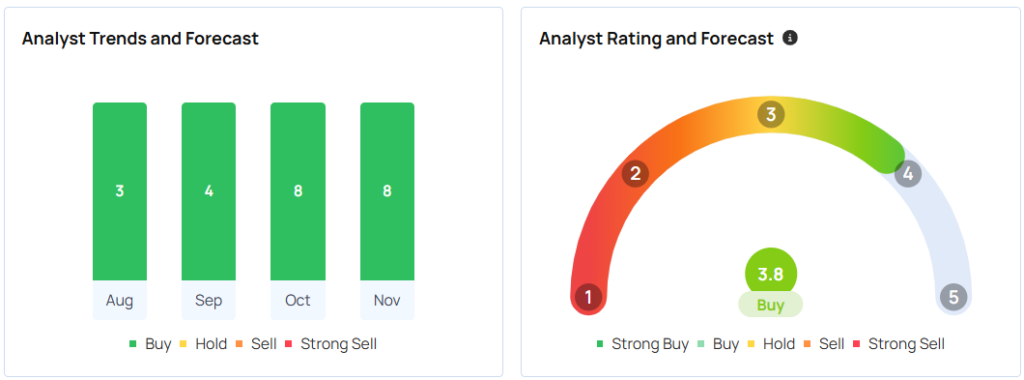
Read Next:
Photo courtesy: Wikimedia
© 2024 Benzinga.com. Benzinga does not provide investment advice. All rights reserved.
How to Retire at 70 With $250K in Savings and $3,000 Monthly Social Security
SmartAsset and Yahoo Finance LLC may earn commission or revenue through links in the content below.
If you’re in your mid-60s and still working, it may be time to start seriously planning for retirement. That doesn’t mean you need to leave work immediately, but retirement is likely on the horizon.
Imagine you’re 65 years old, you have $250,000 in an IRA and expect to receive $3,000 per month from Social Security. Can you retire at age 70? Depending on your personal circumstances and risk tolerance, This could be enough money to generate some financial security, although much of your flexibility would depend on how you manage the IRA for the next five years.
If you need additional help planning for retirement, consider speaking with a financial advisor.
If you plan to retire in five years and have $250,000 in your portfolio, how you manage your IRA will go a long way to determining what kind of retirement you can expect. Five years isn’t a lot of time, but it’s still enough time for some significant growth. Consider these three hypothetical scenarios:
Currently, investment-grade bonds are paying an average 5.6% yield. If you invest your whole IRA into bonds right now, you could expect to retire with about $328,291. Since bonds issue a rate of return backed by the credit of the underlying institution, your odds of volatility or loss are low.
Investing all of your assets in an S&P 500 index fund could produce higher returns than bonds, but it’s a riskier option. But based on the market’s approximate average rate of return (10%), putting everything into the stock market could potentially leave you with $402,628 by age 70. And if you had lots of time for the market’s fluctuations to even out, this might be an excellent plan. But five years is likely too short of a window to justify investing 100% in equities.
Conventional wisdom is to split your assets into a mix of stocks and bonds. By your 60s, this is often either a return-heavy portfolio of 60% stocks and 40% bonds or a safety-heavy portfolio of 20% stocks and 80% bonds. Historically, a 60/40 portfolio has grown at around 8.77% per year, according to Vanguard. While past performance doesn’t guarantee future results, if we assume your IRA grows at 8.77% per year over the next five years, it would be worth about $380,615 by age 70.
None of these strategies will transform your financial situation, but a strategic mix of stocks and bonds could provide you with a combination of growth and safety. A financial advisor can potentially help you find an asset allocation aligned with your risk tolerance and goals.
Commercial Aircraft Manufacturing Market Demand Rising at a Stellar 6% CAGR to Reach USD 565.89 Billion by 2034: Fact.MR Report
Rockville, MD, Nov. 26, 2024 (GLOBE NEWSWIRE) — According to a newly published research report by Fact.MR, a market research and competitive intelligence provider, turnover of the global commercial aircraft manufacturing market is analyzed to achieve a value of US$ 328.32 billion in 2024. The market is forecasted to rise at a CAGR of 6% from 2024 to 2034. The growing volume of international trade and expanding e-Commerce sectors are prominent factors that are contributing to the market expansion worldwide.
To fulfill the demands of customers for reliable and prompt product delivery, airlines are expanding their cargo capacity. Along with purchasing specialized cargo aircraft, several airlines are transforming their existing passenger aircraft into freighters to improve operational efficiency. Air freight services are becoming more popular, which is driving the market for commercial aircraft manufacturing in an upward direction. Because of this, manufacturers are compelled to increase output to meet the evolving needs of airlines and the greater logistics industry.
Throughout the projection period, North America is analyzed to hold a sizable market share of commercial aircraft manufacturing. The region’s market is expanding due to the presence of well-known manufacturers, such as Boeing and Lockheed Martin, who hold a significant portion of the market because of their extensive line of commercial and defense aircraft.
For More Insights into the Market, Request a Sample of this Report:
https://www.factmr.com/connectus/sample?flag=S&rep_id=10487
 Key Takeaways from Market Study
Key Takeaways from Market Study
- The worldwide market for commercial aircraft manufacturing is forecasted to reach a size of US$ 565.89 billion by 2034-end.
- North America is analyzed to register revenue worth US$ 86 billion in 2024.
- The market in South Asia & Pacific is evaluated to increase at 3% CAGR through 2034.
- The East Asia region is projected to achieve a valuation of US$ 62.81 billion by the end of 2034.
- The aerospace manufacturers & aftermarkets segment is approximated to expand at 3% CAGR from 2024 to 2034.
- Demand for aircraft parts and components is estimated to reach US$ 129.02 billion in 2024.
- The market for commercial aircraft manufacturing in South Korea is forecasted to rise at 7% CAGR between 2024 and 2034.
“To offer a wide range of aircraft, including specialized military and cargo aircraft, as well as larger commercial planes and smaller regional jets, prominent commercial aircraft manufacturers are focusing on expanding their product lines,” says a Fact.MR analyst
Leading Players Driving Innovation in the Commercial Aircraft Manufacturing Market:
Key manufacturers of commercial aircraft are Boeing Co., Embraer SA, Mitsubishi Aircraft Corporation, Bombardier Inc., Textron Inc., Lockheed Martin, Dassault Aviation SA, Pilatus Aircraft Ltd., Airbus, Sukhoi Civil Aircraft, Honda Aircraft Company
Aircraft Parts & Components Segment Continues to Hold Leading Position
Compared to other products and services, there is a significant demand for airplane parts and components. Because of the growing number of commercial fleets and international air traffic, a steady supply of replacement parts is needed to ensure aircraft performance and safety. The need for specialized parts that reduce emissions and increase fuel efficiency is also driven by advancements in aviation technology, such as the use of more intricate systems and materials.
Both manufacturers and airlines are spending money on premium parts to guarantee adherence to safety and maintenance guidelines. Because of the expansion of aftermarket services, such as repairs and modifications, there is a continuous demand for aviation components even as older aircraft are decommissioned.
Get Customization on this Report for Specific Research Solutions:
https://www.factmr.com/connectus/sample?flag=S&rep_id=10487
Commercial Aircraft Manufacturing Industry News:
India’s civil aviation minister, K Rammohan Naidu, announced in October 2024 that the government would like to collaborate with industry leaders to expand the country’s ability to develop and manufacture aircraft. The Bhartiya Vayuyan Vidheyak Bill 2024, which includes controls over aircraft design and production, was approved by the Lok Sabha in August in accordance with the Aatmanirbhar Bharat program.
More Valuable Insights on Offer
Fact.MR, in its new offering, presents an unbiased analysis of the commercial aircraft manufacturing market, presenting historical demand data (2019 to 2023) and forecast statistics for 2024 to 2034.
The study divulges essential insights into the market based on product & service (aircraft parts & components, large commercial aircraft, aircraft engines & services, regional & general aviation aircraft, helicopters) and major market (aerospace manufacturers & aftermarket, airlines, leasing & logistic companies, businesses, individuals & governments), across seven major regions of the world (North America, Western Europe, Eastern Europe, East Asia, Latin America, South Asia & Pacific, and MEA).
Check out More Related Studies Published by Fact.MR:
Aerospace Parts Manufacturing Market Size is expected to reach over US$ 1.297 trillion by 2033, with a 3.6% compound annual growth rate (CAGR) from its 2023 valuation of US$ 910 billion.
Military Aircraft & Aerospace Manufacturing Market Size is evaluated to reach a valuation of US$ 339.6 billion in 2024 and is slated to increase at a CAGR of 8.4% to reach US$ 761.97 billion by 2034.
Aircraft Pumps Market Sales are expected to exceed US$ 6 Bn by registering a positive CAGR of nearly 5% in the forecast period 2022-2032.
Aviation Asset Management Market Size is estimated to be worth over USD 178.50 billion in 2022 and is anticipated to expand at a compound annual growth rate (CAGR) of over 5% during the forecast period. By 2032, the aircraft asset management market is projected to be valued at US$290.76 billion.
Aircraft Refurbishing Market Size is increased at a 6.1% CAGR from 2018 to 2022, reaching a valuation of US$ 4.67 billion in 2023. By 2033, it is anticipated to have grown at a 5.8% CAGR to reach US$ 8.21 billion.
eVTOL Aircraft Market Size is expected to be worth US$ 422.2 million in 2024. It is projected to expand at a CAGR of 21.5%. A valuation of US$ 2,959.9 million is expected by 2034 for eVTOL aircraft sales.
About Us:
Fact.MR is a distinguished market research company renowned for its comprehensive market reports and invaluable business insights. As a prominent player in business intelligence, we deliver deep analysis, uncovering market trends, growth paths, and competitive landscapes. Renowned for its commitment to accuracy and reliability, we empower businesses with crucial data and strategic recommendations, facilitating informed decision-making and enhancing market positioning.
With its unwavering dedication to providing reliable market intelligence, FACT.MR continues to assist companies in navigating dynamic market challenges with confidence and achieving long-term success. With a global presence and a team of experienced analysts, FACT.MR ensures its clients receive actionable insights to capitalize on emerging opportunities and stay competitive.
Contact:
11140 Rockville Pike
Suite 400
Rockville, MD 20852
United States
Tel: +1 (628) 251-1583
Sales Team: sales@factmr.com
Follow Us: LinkedIn | Twitter | Blog

© 2024 Benzinga.com. Benzinga does not provide investment advice. All rights reserved.
US Stocks May Have A Slow Start As Trump's Tariff Threat Begins To Thwart Relief Rally: Analysts Remain Optimistic About AI-Linked Sectors Stocks
U.S. stocks could open on a sluggish note on Tuesday after ending in green on Monday as President-elect Donald Trump threatened to hit two of U.S.’s largest trading partners – Canada and Mexico – with tariffs.
The Dollar Index strengthened and was hovering around the 107 level. Expectations of a further 25 basis point rate cut in December have fallen to just 59% now, down from 75% a month ago, according to CME Group’s FedWatch tool.
| Futures | Performance (+/-) |
| Nasdaq 100 | 0.08% |
| S&P 500 | 0.09% |
| Dow Jones | 0.07% |
| R2K | -0.26% |
In premarket trading on Monday, the SPDR S&P 500 ETF Trust SPY was up 0.06% to $597.87 and the Invesco QQQ ETF QQQ rose 0.04% to $506.80, according to Benzinga Pro data.
Cues From The Last Session
The Dow Jones closed higher by around 440 points to 44,736.57 on Monday. The S&P 500 rose 0.30% to 5,987.37, while the Nasdaq Composite rose 0.27% to close at 19,054.84 during Monday’s session.
On the economic data front, the Chicago Fed National Activity Index fell to -0.40 in October compared to -0.27 in the previous month and versus market estimates of -0.20.
The Dallas Fed’s Texas manufacturing activity index rose to -2.7 in November compared to a reading of -3 in the previous month and versus market estimates of -2.4.
Most sectors on the S&P 500 closed on a positive note, with real estate, materials, and consumer discretionary stocks recording the biggest gains on Monday.
However, energy and information technology stocks bucked the overall market trend, closing the session lower.
| Index | Performance (+/-) | Value |
| Nasdaq Composite | 0.27% | 19,054.84 |
| S&P 500 | 0.30% | 5,987.37 |
| Dow Jones | 0.99% | 44,736.57 |
| Russell 2000 | 1.47% | 2,442.03 |
Insights From Analysts:
“Equity markets continue to display remarkable strength. The S&P 500 and other major indices are flirting with or surpassing all-time highs. The breadth of the rally is particularly noteworthy, with a growing number of stocks hitting 52-week highs,” said Jeremy Siegel, a senior economist at WisdomTree.
“This breadth is a key signal of market health, as it indicates a robust and inclusive rally rather than one concentrated in a few mega-cap names,” he added.
Analysts at BlackRock said that they are positive about the AI theme in the technology sector. “Valuations for AI beneficiaries are supported as tech companies keep beating high earnings expectations. We think upbeat sentiment can broaden out,” their note said.
BlackRock also added that they see the AI buildout and adoption creating opportunities across sectors. “We get selective, moving toward beneficiaries outside the tech sector. Broad-based earnings growth and a quality tilt make us overweight U.S. stocks overall.”
Predicting how December could look like for the stock markets, Ryan Detrick, chief market strategist at Carson Group, highlighted how markets have performed better than average in December in every election year since 1950.
Upcoming Economic Data:
This week’s economic calendar is not as packed as last week’s due to Thanksgiving. Here are the key events lined up for Tuesday:
- The S&P Case-Shiller home price index for 20 cities will be released at 9 a.m. ET.
- Data on consumer confidence and new home sales will be released at 10 a.m. ET.
- The minutes of the Fed’s November FOMC meeting will be released at 2 p.m. ET.
Stocks In Focus:
- Woodward Inc. WWD is up by almost 11% in premarket trading after Pathstone Holdings LLC boosted its position by 28.6% during the 3rd quarter, as per SEC filing. The company also reported a record revenue of $3 billion in the September quarter, aided by the performance in both aerospace and industrial segments.
- Rivian Automotive Inc. RIVN rose 6% in premarket as it reacted to reports that Tesla Inc TSLA reached a “conditional” settlement concerning a 2020 lawsuit. The Elon Musk-led company had accused Rivian of poaching Tesla employees to get ahold of its EV trade secrets.
- Exact Sciences Corp. EXAS was trading above 5.5% in premarket after the company advanced breast cancer care with the Oncotype DX test and genomic profiling research at the San Antonio Breast Cancer Symposium 2024.
- Semtech Corp. SMTC was up over 19% in premarket hours after the chipmaker reported a strong set of earnings. The company posted revenue of $236.8 million for the quarter with quarterly earnings of $0.26 per share as compared to $0.02 per share a year ago.
- Blue Bird Corp. BLBD was down over 10% in premarket after its fourth-quarter earnings missed analyst estimates. The quarterly earnings of $0.77 per share missed the Zacks Consensus Estimate of $0.78 per share. This compares to the EPS of $0.66 in Q4 of the previous fiscal.
- Investors are awaiting earnings results from Best Buy Co., Inc. BBY, HP Inc. HPQ, and Dell Technologies Inc. DELL today.
Commodities, Bonds And Global Equity Markets:
Crude oil futures rose in the early New York session, advancing 0.93% to hover around $69.57.
The 10-year Treasury note yield eased to 4.293%.
Major Asian markets ended lower on Tuesday, except for Hong Kong’s Hang Seng Index. European markets were also down in early trading.
Read Next:
Photo courtesy: Wikimedia
Market News and Data brought to you by Benzinga APIs
© 2024 Benzinga.com. Benzinga does not provide investment advice. All rights reserved.
Qualcomm's Interest In Taking Over Intel Wanes Due To 'Complexities' Involved: Report
Qualcomm Inc.’s QCOM interest in acquiring Intel Corp. INTC is reportedly waning due to the “complexities” involved.
What Happened: The challenges of executing such a deal with Intel have cooled Qualcomm’s enthusiasm, Bloomberg reported.
In September, reports suggested that Qualcomm approached Intel for a potential takeover, which would have been a significant merger in the tech sector.
Qualcomm might still consider purchasing parts of Intel or revisiting the idea of a full acquisition in the future.
This comes after Qualcomm outlined its strategy last week to diversify its business, aiming to boost annual revenue by $22 billion by 2029. CEO Cristiano Amon stated in an interview that no major acquisition is currently deemed necessary to achieve this target.
Qualcomm and Intel did not immediately respond to Benzinga’s request for comment.
Intel, once a leader in the chip industry, has faced setbacks, losing ground in the AI chip market.
In August, Intel announced a $10 billion cost-cutting initiative, including workforce reductions and dividend suspension. Analysts have expressed skepticism about the potential deal, citing risks and financial implications for Qualcomm.
Subscribe to the Benzinga Tech Trends newsletter to get all the latest tech developments delivered to your inbox.
Why It Matters: The potential acquisition of Intel by Qualcomm has been a topic of interest since September, when Qualcomm reportedly considered the takeover amid Intel’s 60% stock decline.
However, antitrust concerns have posed significant hurdles. Furthermore, analysts have expressed doubts about the feasibility of such a merger, citing regulatory challenges.
Adding to Intel’s challenges, the company is set to receive less than $8 billion in federal CHIPS Act funding, a reduction from the $8.5 billion initially planned. This funding cut comes as Intel struggles to meet its revenue targets with its Gaudi AI chips, as noted by CEO Pat Gelsinger during a third-quarter earnings call. The uptake of these chips has been slower than expected, impacting Intel’s financial outlook.
Price Action: Qualcomm stock gained 1.3% on Monday to close at $158.82, while Intel’s stock rose 1.5% to close at $24.87. Year-to-date, Qualcomm shares are up 13.3%, while Intel’s shares are down 48%, according to Benzinga Pro data.
Check out more of Benzinga’s Consumer Tech coverage by following this link.
Read Next:
Disclaimer: This content was partially produced with the help of AI tools and was reviewed and published by Benzinga editors.
Photo courtesy: Shutterstock
Market News and Data brought to you by Benzinga APIs
© 2024 Benzinga.com. Benzinga does not provide investment advice. All rights reserved.


